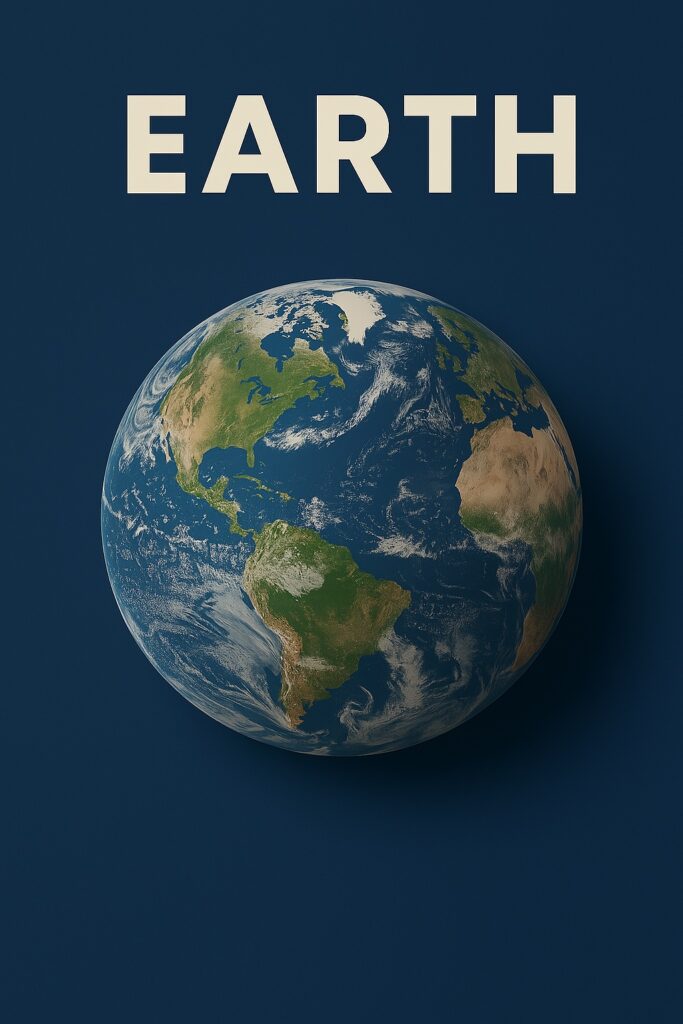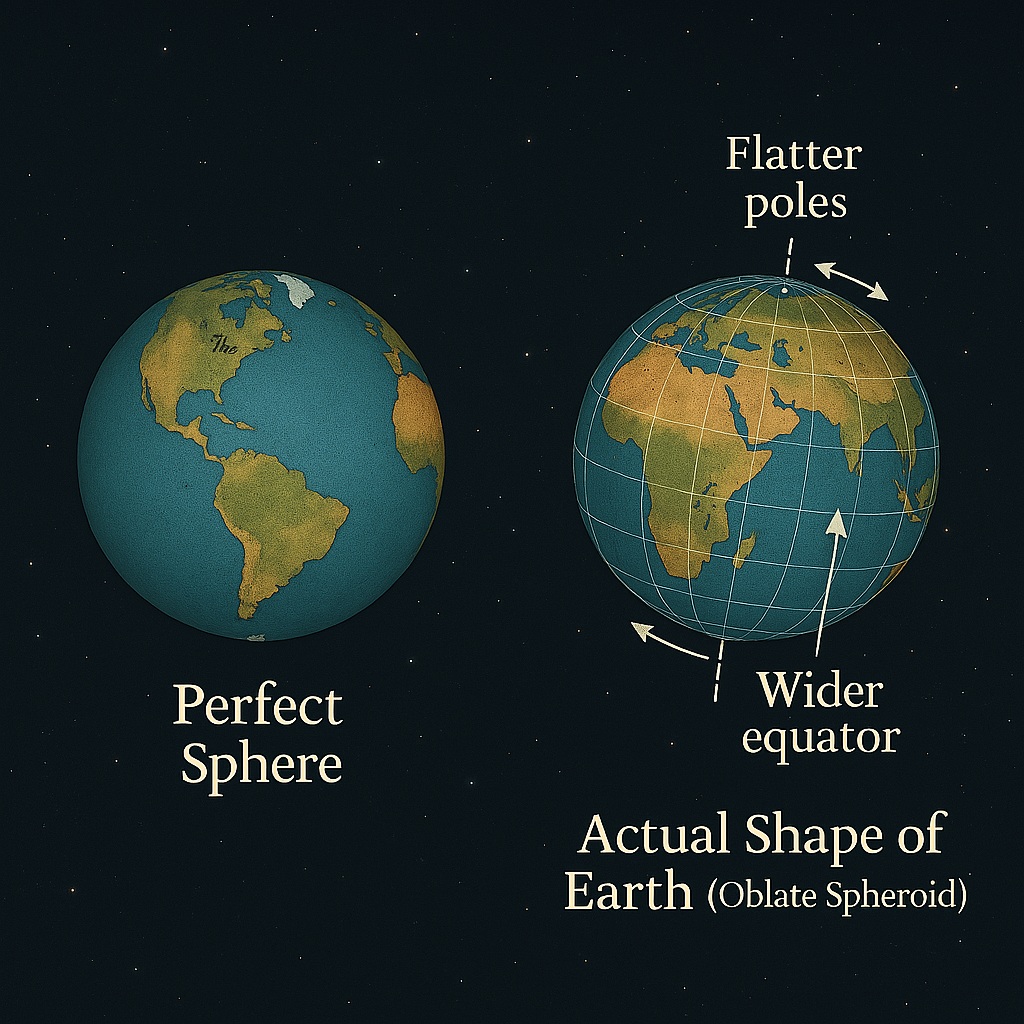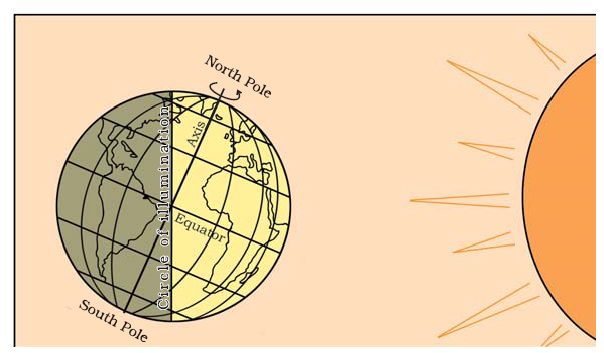The Earth is unique among planets due to its ability to support life, thanks to the right mix of land, water, air, temperature, and energy. It is part of the solar system and orbits the Sun. Its spherical shape slightly bulges at the equator due to rotation. The Earth has a layered structure: the crust, mantle, and core.

Table of Contents
Shape of the Earth
A famous Indian astronomer, Aryabhatta (5th century A.D.), proved that the Earth is round (a sphere) even without using modern tools. He also showed for the first time that Earth spins on its axis. Another Indian astronomer, Varahmihir, also confirmed that the Earth is spherical.

Movements of the Earth
The Earth is always in motion. It moves in two major ways: Rotation and Revolution. These movements are responsible for various natural events like day and night, seasons, and the changing length of days.
Rotation (Spinning of the Earth)
The Earth rotates or spins around an imaginary line called the axis, which passes through the North and South Poles. This movement is called rotation.
- Direction of Rotation: West to East
- Time Taken: 24 hours (1 day)
- Axis Tilt: The Earth’s axis is tilted at an angle of 66.5° to its orbital plane
Effects of Rotation:
- Causes day and night
- Makes the Sun appear to rise in the east and set in the west
- Responsible for the difference in time across different longitudes
Example: When India is facing the Sun, it experiences day; at the same time, the USA, on the opposite side, has night.

Revolution (Orbiting Around the Sun)
Along with spinning, the Earth also moves around the Sun. This movement is known as revolution.
- Path of Movement: Elliptical orbit
- Time Taken: 365¼ days (1 year)
- Speed of Movement: About 29.8 km per second

Effects of Revolution
- Causes the change of seasons
- Leads to variation in the length of days and nights
- Responsible for the year and the calendar
Why Seasons Occur?
- The Earth’s axis is tilted, so different parts of the Earth receive different amounts of sunlight during the year.
- This tilt, along with revolution, causes summer, winter, spring, and autumn.
Summer Solstice (June 21)
The Summer Solstice is the day when the Northern Hemisphere is tilted most directly toward the Sun.
-
Date: Around 21st June
-
Sunlight: The longest day and shortest night in the Northern Hemisphere
-
Sun’s position: Directly overhead at the Tropic of Cancer (23.5°N)
-
The Southern Hemisphere experiences winter during this time
-
Marks the start of summer in the Northern Hemisphere
-
Areas near the Arctic Circle experience midnight sun (24 hours of daylight).
-
Sun is at its highest position in the sky at noon.
Winter Solstice (December 22)
The Winter Solstice occurs when the Northern Hemisphere is tilted away from the Sun.
- Sunlight: The shortest day and longest night in the Northern Hemisphere
- Sun’s position: Directly overhead at the Tropic of Capricorn (23.5°S)
- Marks the start of winter in the Northern Hemisphere
- The Southern Hemisphere has summer at this time
- Near the Arctic Circle, there may be 24 hours of darkness (polar night).
- The Sun is at its lowest position in the sky at noon.
Equinox (March 21 and September 23)
The Equinox is the time when both hemispheres receive equal sunlight, because the Sun is directly over the Equator.
- Day and night are equal in length all over the world (12 hours each)
- Sun’s position: Directly overhead at the Equator
- Marks the beginning of spring (March) or autumn (September) in the Northern Hemisphere
- Equinoxes help in dividing the year into equal halves based on daylight.
What is Leap Year?
A Leap Year occurs due to the way the Earth revolves around the Sun. While we commonly say that a year is 365 days, the Earth actually takes a little more than that to complete one full orbit.
-
The Earth takes about 365.25 days (365 days and 6 hours) to complete one full revolution around the Sun.
-
However, our calendar year is only 365 days long.
-
This creates a difference of ¼ day (6 hours) each year.
-
That extra ¼ day each year is not ignored.
-
After 4 years, ¼ + ¼ + ¼ + ¼ = 1 extra day.
-
So, to adjust this difference, we add 1 extra day (February 29) every 4 years.
This year with 366 days is called a Leap Year.
How Earth supports life?
Even though Earth is very small in the vast universe, it is very special. It is the only planet where life exists—animals, plants, and tiny organisms live here.
Earth’s Distance from the Sun
-
Earth and other planets get energy from the Sun.
-
Mercury and Venus are too close to the Sun, making them too hot—even metals like lead can melt there!
-
Some planets are too far from the Sun and are extremely cold, where even gases freeze.
-
Earth is at just the right distance from the Sun. That’s why the temperature here is perfect for life—around 15°C on average.
-
This temperature allows water to exist in all three forms: solid, liquid, and gas.
-
Life began and grew in water, so water is essential for life. That’s why plants grow and animals survive here.

Three Life-Supporting Layers on Earth
Earth is the only planet that has all three important layers needed for life:
-
Atmosphere (air)
-
Hydrosphere (water)
-
Lithosphere (land)
-
Planets like Mercury, Venus, and Mars have air and land, but no water.
-
Gas planets like Jupiter and Saturn don’t have solid land or water—so no life is possible there.
Right Mixture of Gases in the Atmosphere
- Earth’s air is made up of just the right amounts of nitrogen and oxygen, with a little bit of carbon dioxide and ozone.
- If there is no oxygen even for a few seconds, we start feeling uncomfortable.
- Other planets like Venus and Mars have mostly carbon dioxide in their air.
- On Jupiter, the main gases are hydrogen and helium.

Ozone Layer Protection
The ozone layer in our atmosphere protects us by absorbing harmful ultraviolet rays from the Sun. Without it, these rays could harm plants, animals, and humans.

Balanced Duration of Day and Night
On Earth, day and night are about 12 hours each, which is perfect for life.
-
On Mercury, night lasts as long as 30 Earth nights.
-
On Venus, night lasts for about 122 Earth nights.
-
On Jupiter and Saturn, night may last only about 5 hours.
Because of Earth’s balanced conditions, life has thrived:
-
There are about 14 lakh animal species and 5 lakh plant species on Earth.
-
Some plants and animals have gone extinct, while new ones have evolved to adjust to changes in the environment.
Moon
The Moon looks about the same size as the Sun in the sky, but actually:
-
The Sun is 400 times bigger than the Moon.
-
The Moon is 400 times closer to Earth than the Sun. So, to our eyes, they look the same size.
The Moon spins on its axis and also orbits the Earth, completing both movements in 29½ days. Because both rotations take the same time, we always see only one side of the Moon. The other side of the moon is not visible from the Earth.
"A light year is the distance that light travels in one year at a speed of 300,000 km/second.
Source of Light of Moon
-
The Moon is opaque (not see-through) and has no light of its own.
-
It shines by reflecting sunlight.
Phases of Moon
The Moon’s shape seems to change daily. This is due to its revolution around Earth:
-
From New Moon (Amavasya) to Full Moon (Purnima), more of the Moon becomes visible—this is called Shukla Paksha.
-
From Full Moon to New Moon, the visible part reduces—this is called Krishna Paksha.
Man on Moon
On July 20, 1969, the spaceship Apollo-11 carried Neil Armstrong (from the USA) to the Moon. He became the first human to walk on the Moon and said: “That’s one small step for man, one giant leap for mankind.”
-
The Moon is the only space body where humans have landed.
-
Neil Armstrong was the first person to walk on the Moon on July 20, 1969.
-
Till now, 12 astronauts have walked on the Moon.
-
Many missions from the USA and Russia have explored the Moon.
-
The Moon’s surface has rocks, dust, stones, and no air.
-
It has no fossil, no plants, no animals, and no signs of life.
-
It is completely dry and lifeless.
-
No air and no water means no life can exist.
-
A person who weighs 60 kg on Earth would weigh just 10 kg on the Moon because gravity is weaker.
-
You can jump six times higher on the Moon than on Earth.
Age of Moon
- The Moon is as old as the Earth—about 4.6 billion years.
- Just like earthquakes, the Moon has moonquakes.
- There is no atmosphere on the Moon, so you can’t hear sounds.
- Talking is only possible through signs or gestures.
Temperature at Moon
-
Daytime temperature: can go up to 134°C
-
Nighttime temperature: drops to –170°C
-
It’s extremely hot in the day and freezing cold at night.
Artificial Satellites
Imagine you’re sitting on your roof reading a book. You fall asleep with the book open on your lap. The next day, you see a picture of yourself and your book in the newspaper. That’s how powerful artificial satellites are—they can even capture such detailed images!
These satellites orbit the Earth with powerful cameras and lenses and can see everything happening on the planet.
The first artificial satellite was named Sputnik, launched by the USSR (now Russia) on October 4, 1957. It was the first human-made object to orbit the Earth and began the era of space exploration.
Women have also contributed greatly—Valentina Tereshkova was the first woman astronaut to travel in space.
Uses of Artificial Satellite
Artificial satellites are very useful in our daily lives. They have changed the way we communicate. You can now talk to anyone around the world easily and cheaply. Thanks to communication satellites, radio and TV programs can now reach remote villages and even foreign countries. For example, you can watch live cricket or hockey matches happening in other countries.
"India's first satellite, Aryabhata, was launched on April 19, 1975.
- Educational TV programs are shown all over India for students. In video teleconferences, students can ask questions and get answers in real time.
- News reporters can also send updates instantly to news channels using satellites.
Satellites also give us weather updates and help in warning about natural disasters like cyclones or floods. -
Geologists use satellites to find minerals and underground water.
-
Oceanographers use them to spot large groups of fish in oceans.
-
Archaeologists find digging/excavation sites with the help of satellite images.
-
Satellites provide maps for city planning, growing forests, and spotting illegal crops.
-
Spying satellites help in defense. For example:
-
The USA found out about India’s nuclear test in Pokhran using satellites.
-
During the Gulf War in 1991, the USA used satellites for spying and launching missiles.
-
Satellite Lifespan
Most satellites and spaceships work for about 6–7 years. After that, they stop working and start floating around in space. There are now thousands of broken satellites and parts revolving in space. These can be dangerous because they might:
-
Hit new satellites or spaceships.
-
Fall to Earth and cause accidents.
Read: Geography Notes